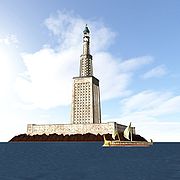
Today was a pretty good day. I went diving in the ruins of the Lighthouse of Alexandria, one of the original Seven Wonders of the Ancient World. It was the most unique dive I’ve ever done on many different levels: it was the coldest dive I’ve ever done at 15C (59F), the shallowest dive I’ve ever done at only 8m, it was the worst visibility I’ve ever had on a dive, and the only archeological dive I’ve ever done.
The Lighthouse of Alexandria was the architectural landmark of Alexandria during the Ptolemaic dynasty and during Roman rule. Also known as the Pharos, it got its name from the small island it was situated on in the Alexandria harbor. It was estimated to be between 115 and 150 m (380 and 490 ft) tall, which would put it on a par with the Great Pyramid. The lighthouse was destroyed in the early 14th century from earthquakes, and in the 15th century, Sultan Qaitbey built a fort on the site. The fort is still there today.
Surprisingly, no one knew that parts of the lighthouse were in the sea until a team of divers discovered in 1994. I say surprisingly only because the water is shallow enough where someone could free dive from the surface and see the large stones. In 700 years, no one bothered to look.
There were only me and a Canadian guy who did the dive today. This isn’t really the high season for tourists and given the water temperature, not a great time for divers. I had to wear a full 5mil wetsuit with a hood and boots. All of the previous dives I’ve done have been in tropical climates where at best you only needed a light, half wetsuit. The only part of my body which was exposed was my hands the area around my mouth and eyes not covered by my goggles.
The dive was run by Alexandria Divers, the only dive shop in town.
The first dive was outside the harbor wall. Visibility wasn’t too bad at about 10-12m. Everywhere you went were large rectangular blocks, pillars, stone chairs, and sphinxes. Before most dives, you have a short meeting with the divemaster to go over hand signals. They had special ones to identify is something was Roman, Greek or Egyptian or if it was a pillar or part of the lighthouse. From the maps of the area I’ve seen, there is a lot more there that we didn’t see. While air supply isn’t an issue at that depth, the temperature still was and we had a good hour in the water.
The second dive was inside the harbor and the main attraction was an Italian fighter which crashed during WWII. There were also jars, vases, and lamps strewn about the seafloor. Visibility here was horrible. It was maybe 2m at best and it was very easy to get lost and lose sight of the people you were diving with. I was sort of surprised at the number of artifacts I was able to see. I figured most of them would have been hauled up and put in a museum by now.
If you are a diver and are going to Egypt, the Alexandria dive is something you should consider. There aren’t many non-wreck, archeological dives in the world you can do. The price is sort of steep at 100 Euros for 2 dives, but it isn’t outrageous. If you go in the summer, I think it would be a much more enjoyable experience. Water temperature in the summer can reach 25C (77F) which is a much nicer environment for diving than 15C. Most divers in Egypt go to the Red Sea. Alexandria isn’t too far to go if you want to do something different.

Hi, thank you for this contribution. Did you went free diving in cleopatra’s palace too?
This sounds amazing, Gary. Not sure if you've mentioned this before but, were you a diver before you left on your trip or is this something you've picked up along the way? I'm starting to get more and more interested in diving and was wondering how much swimming experience one needs to get certified, etc. And is it scary? :D
Thanks! I think this particular dive is pretty unique.
I never dove before I started my trip.
You should be a good swimmer obviously. Diving isn't scary. It is very hard to drown while diving. You have so much stuff on you that makes you float that sinking is a bigger problem than floating.
So long as you don't try to do stupid things outside of your expertise, it is very safe and fun. If you don't dive, there is a large chunk of the Earth you'll never get to experience.
I first learned about this when I read Pagan Holiday (also published as Route 66 AD). Somehow the author never made it through the red tape to actually make the dive, but he did write a bit about it.
Wow, I never knew you could do this either!
I'm used to wearing a hood, boots, etc because I got SCUBA certified in California (our water at dive depths can get fairly cold – in fact some Canadian dive instructors I met in the Bahamas shivered when I told them where I'd done my certification!). That being said, I much prefer tropical diving areas. I'm definitely putting this on my List if I find myself near this area!
Thanks for sharing!
Thanks for sharing! I remember watching a special about all of the wrecks and artifacts around that area, but i'm very surprised to hear the extent of it. Sounds like a pretty fascinating cross section of history.